A few weeks ago, Dave from the For Keeps podcast reached out to me about my View-Master collection and asked if I’d like to share the story on his podcast.
I agreed to do it, and I’m glad I did. It was a fun experience. You can check it out here.
writer, editor, crafty gal
A few weeks ago, Dave from the For Keeps podcast reached out to me about my View-Master collection and asked if I’d like to share the story on his podcast.
I agreed to do it, and I’m glad I did. It was a fun experience. You can check it out here.
Most folks are just here for the View-Master stuff. I collect, buy and sell View-Master viewers and reels. Do you have some that you want to sell or trade or give to a good home? Let me know!
Find me writing about View-Master and other topics on my newsletter.
You can follow my View-Master posts on Instagram:
The Gizmodo segment and article on my collection:
The For Keeps podcast I did about collecting View-Master.
ToyTales.ca’s Collector Spotlight article.
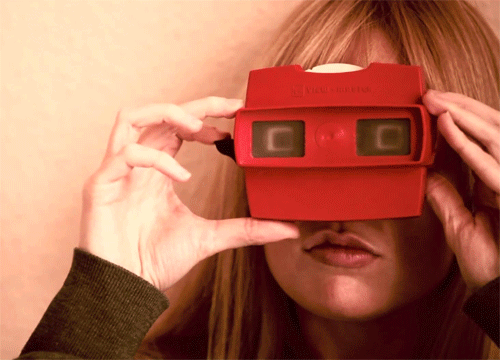
The Pathfinder I made that resulted in all this weird attention: Collecting View-Master Viewers and Reels (semi-regularly updated since 2012 when I made it for a grad school assignment) is a primer on View-Master collecting and a good place to start if you’re learning.
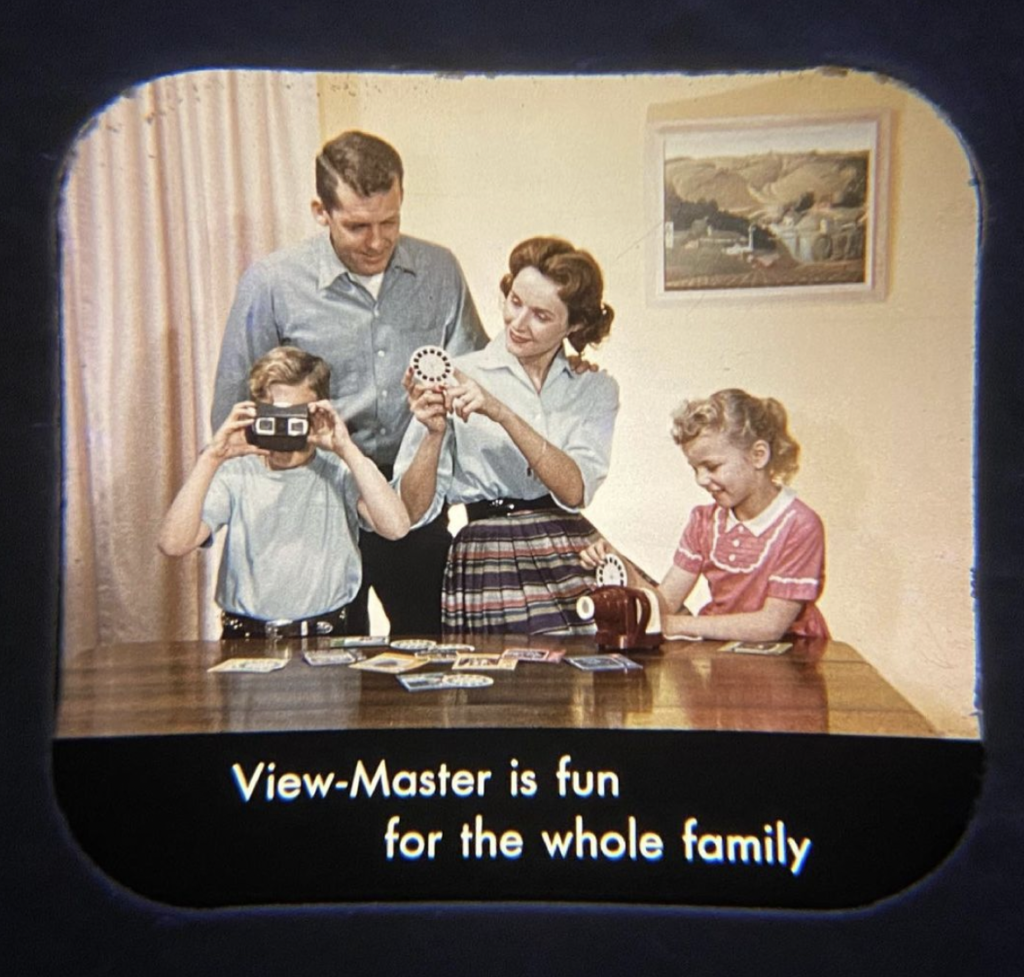
Check out this article I wrote for Stereosite: NOSTALGIA, SEMIOTICS & WEIRD STUFF: A GUIDE TO COLLECTING VIEW-MASTER
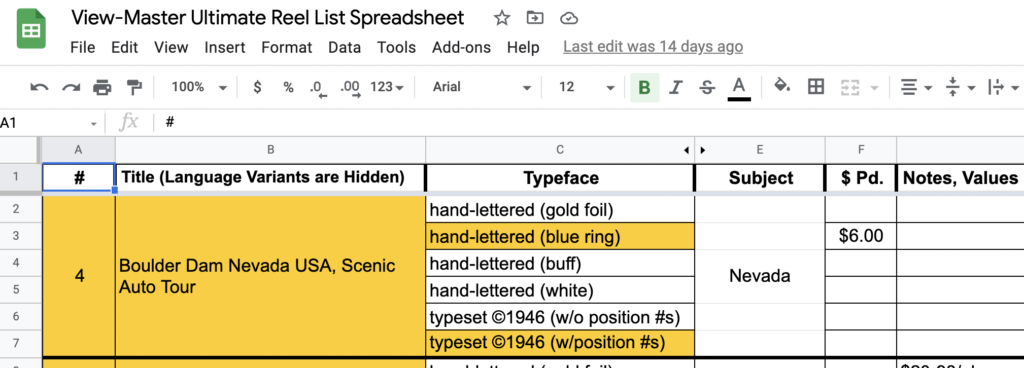
If you’re a View-Master collector looking for a way to track your collection and see what you do and don’t have, I made this Google spreadsheet. Feel free to make a copy for yourself to keep track of your collection.
I’ve had several people reach out to me recently to talk to me about View-Master collecting. Weird for multiple reasons not the least of which is that I could point you in the direction of several people who are much more dedicated to View-Master collecting than I am.
I liked View-Master as a kid because it dovetailed nicely with my love of movies, TV, and escapism in general. I’ve always loved visual media. I have a degree in film studies, and I’ve always loved picking things apart. I didn’t know this was called semiotics when I first started doing it, but I guess that’s a big piece of what I liked about View-Master.
Other things I like about it include seeing things I normally wouldn’t or couldn’t see, playing with a mid-century novelty device, getting to peek into the past, picking apart and considering the images and their composition and meaning, as well as the device’s overall connection to pop culture over many decades. I also have this pretty sweet spreadsheet I get to work on whenever I get new reels, and that is deeply satisfying.
There are also individual reels and recurring themes I enjoy. That list includes flaming dolphins, weird dioramas, great dioramas, sad animals in zoos, images of countries I’ve never visited (often from the 1940s), the delightfully crazy way people once bored holes into ancient trees just for the novelty, the way folks could touch all the walls on a cave tour and didn’t even care they were ruining it for future generations, and the way white ladies sit overdressed and contemplative while staring at a landscape, to name a few.
There’s certainly an argument to be made that View-Master is a particularly upper middle class and white thing. I don’t think I’m qualified to do that topic justice but it’s important to acknowledge it, I think. Reels and viewers have never been expensive so they weren’t intended for the wealthy, but the images presented in the reels, by and large, offers a glimpse into the destinations of wealthy or worldly white people on vacation at mid-century. I’m not sure if I found it relatable or aspirational when I first started collecting. I didn’t grow up taking vacations regularly. We did little road trips and saw lots of interesting landscapes along the way, however.
One thing I always liked about View-Master, once I began learning about it, was that the creator thought of it as a way to bring the world to everyone. I liked that idea very much. And it’s something I always think about when I see a reel on a topic I haven’t seen before. I liked that they have reels on the history of Chinese art, on how to identify a variety of mushroom types, and that it was used as a tool to teach pilots.
I like it because I still think it’s a tool and a toy that teaches me new things all the time.
Pull out your 3D glasses (the red/blue anaglyph kind)!
This is tangentially related to publishing, right? I have a 3D camera and I’m making my own 3D view-master reels using Image3D.com!
Here is my second reel that I’ll be sending in soon! Get a sneak peak here of Indie Bookstores of the Midwest (that I visited and photographed) in 2012.
Click on any photo to enter the gallery.
My vintage View-Master viewers (just a sampling).
Though it is now known primarily as a child’s toy, View-Master was launched at the 1939 New York World’s Fair as a way to see the world from home in full-color 3-D images. It was marketed as a more exciting souvenir than a traditional postcard and reels were often sold at tourist destinations across the globe. View-Master reels featured beautiful photography of famous places and people through the 1960s.
Medical schools and the U.S. military used View-Master viewers and reels as educational tools, providing educational 3-D images to students of everything from internal organs to fighter planes.
In the 1960s, View-Master underwent a change of ownership and became increasingly targeted at children. The reels of that era de-emphasized education and scenic themes and moved aggressively toward entertainment titles focusing on cartoons and popular television programs.
Interesting rabbit hole to leap down: The Hidden History of View-Master
Today, View-Master is owned by Fisher-Price and is considered a young child’s toy but the collector market thrives online.
Though the look of the viewers themselves has changed over time the reels have remained consistent. Any View-Master brand viewer will show any View-Master brand reel from any decade. Most vintage items are relatively inexpensive, but the price goes up exponentially for rare items.
Looking to buy/sell/trade/give away View-Master stuff to a good home? Let me know.
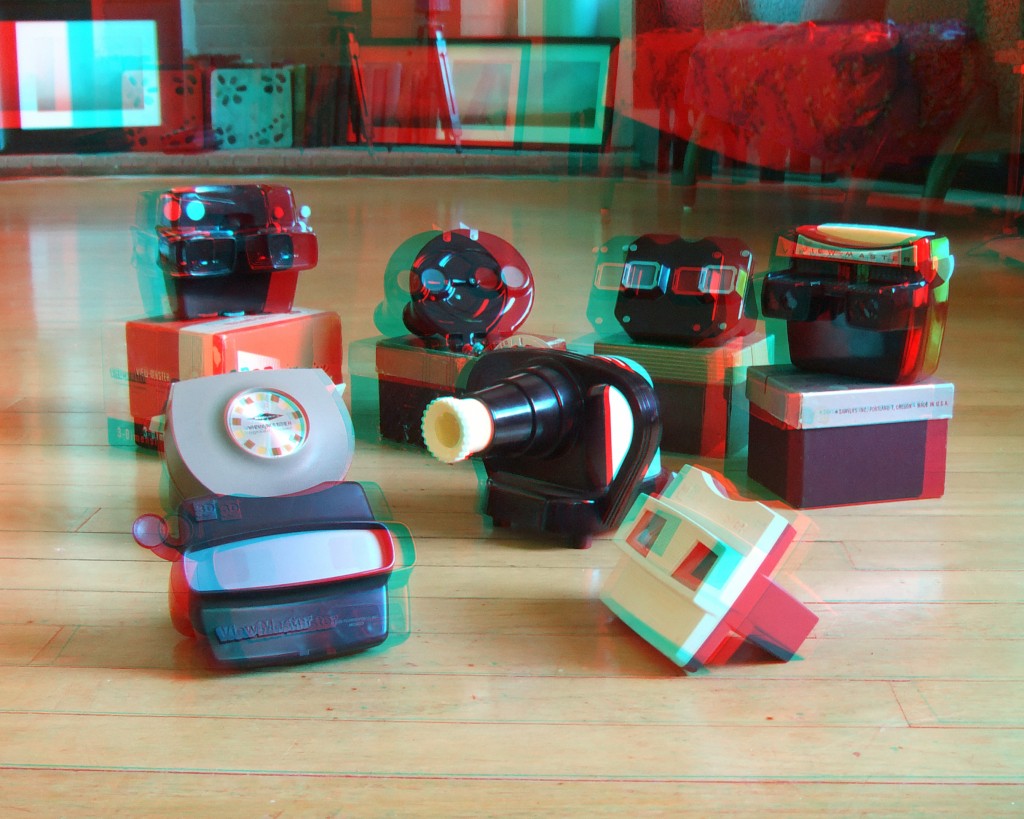
This website provides not only detailed information on every View-Master branded viewer in existence but a long list of knock-off brands with detailed photos and specifications. The site also features images of rare variants in viewers, such as unusual materials or colors used in production. Most importantly for collectors, it offers detailed specifications on the internal projection and overall quality of each View-Master viewer.
The View-Master Single Reel List (Site may be offline?)
While it promotes itself as an animated, searchable list of individual reels, the best thing about this website is the 360-degree videos of every View-Master brand viewer produced since 1939. This is the most comprehensive visual representation online, featuring 20 distinct viewers and their various attachments. From the earliest “clamshell” style viewer to the brightly colored molded plastic viewers used today, this site has them all. There is also an area to view 360-degree videos of each of the four View-Master projectors available on the collectors market.
Spreadsheet made from the Ultimate Reel List
The Ultimate Reel List was an invaluable resource. It listed every known reel by logical numeric or alphabetical grouping as well as every known variant in images. I adapted the site into this handy spreadsheet.
Adapted from the View-Master Ultimate Reel List. From their site: As there was no official list of titles, this View-Master Database is an attempt to build a complete list of every individual reel, set, and their variants known to have been issued. It is hoped that the site will be of value to collectors and can continue to be expanded in the future.
View-Master Single Reel VariantsÂ
From the site: The aim is to make the most comprehensive and complete list of known variations within the same reel variety.
Nostalgia, Semiotics & Weird Stuff
I wrote this photo-heavy article for Stereosite that details some of the key content categories that View-Master covered over the years.
Fisher-Price/Mattel currently owns View-Master and the official site is the place to discover new releases, most of which are for the virtual reality viewers. New releases are limited to children’s titles and education; travel reels have been slowly phased out over the years, finally ending production entirely in March 2009 (though there has been talk off and on over the years, I haven’t seen anything noteworthy in awhile). In early 2013 it was announced that Basic Fun had licensed the View-Master name from Fisher-Price and is producing new products but they are cheap and basically a nostalgic thing for parents and grandparents to buy little kids.
The View-Master Resource provides information on creating personal view-master reels. However, it also helpfully provides scans of envelopes and packaging so if a collector acquires a set of reels without the original envelope it came in, they can print a reproduction from a .pdf file and have a copy of the original packaging. Not as comprehensive as a collector might like but it’s a great a resource if a collector has reels that are in great shape but are missing the packaging.
Stereo Views: An Illustrated History and Price Guide by John Waldsmith (book)
One of the few print resources for View-Master history and values, this exhaustive guide provides a history and context—as well as a price guide that lists most known reels and approximate values at the time of publication. However, it does not list reel variants. Higher values items are generally rare so this book provides a quick reference for what reels are rare and thus worth the added expense, even if the exact market price is outdated. It also provides a history of the precursor to View-Master, the stereoscope and detailed information on the collectability of stereoscopic photo sets.
View-Master Memories by Mary Ann and Wolfgang Sell and Charley Van Pelt (book)
This is a limited edition book written by the foremost View-Master historians and collectors. This book offers both a behind-the-scenes look at the history of the company from interviews conducted with former employees and detailed information about collecting View-Master products.
View-Master Reels and Packets: A Collector’s GuideÂ
A huge, expensive, illustrated guide that is up to three volumes, last I looked. The author died and it’s best to find these volumes on ebay now.
The ViewMaster and 3D Stereo Group
This is a members-only group populated with some of the most knowledgeable View-Master collectors in the world. Anyone may join. New members are welcome to search the archive for information that dates back more than 10 years and to ask questions of members to benefit from the group’s collective wisdom. From collectors selling off their massive collections to questions about the right light bulb to get for a vintage lighted View-Master, the ViewMaster and 3DÂ Stereo Group knows everything a collector wants to know.
The Nation Stereoscopic Association
The NSA is a group dedicated to all things 3-D, with an emphasis on photography. The site includes a long list of links for View-Master enthusiasts. The organization’s annual gathering includes a day of selling and swapping 3-D items with some View-Master collectors in attendance. The annual event is a great chance to scoop up or swap items from other members.
An active Facebook group dedicated to sharing the View-Master love. Lots of knowledgeable members.
It is one of the only stores online to specialize in View-Master viewers and reels, as well as 3-D paraphernalia in general. They offer new reels and old, as well as viewers, generally in excellent condition. They also offer hard to find, limited-run View-Master sets that are independently produced. Topics tend to focus on design and architecture and include reels, a viewer and a book on a specific architect or designer, such as Frank Lloyd Wright.
It is by far the most popular place for collectors to add to their collections. Ebay generally has dozens of pages of search results offering everything from single reels to large lots, from the common to the completely obscure–even personal reels created by amateur stereo photographers during the product’s heyday. Generally considered the only place to find educational reels produced for the military or medical schools, as well as other older and hard-to-find reels.
Online, Craigslist and Facebook marketplace are also good resources. In person, check flea markets and second-hand stores.

I share images from View-Master reels I find.
If you have red/blue 3D glasses this link is an archive to my 3D photos, some of which have made it onto my personal View-Master reels. If you want to create your own View-Master-style reels, check out Image3D.com.
View-Master items, by and large, are inexpensive. Of course, if the item is rare, value goes up exponentially. The best way to find out what your item is worth is to search for it on eBay and check the completed and sold listings in the advanced search functions. Don’t assume anything. The “cool” old bakelite viewers are a dime a dozen because they were produced for decades. But if you have the viewer with the focusing feature (the Model D), you might get a nice return on it.
This pathfinder provides information for those interested in learning more about View-Master products and collecting. It should be of interest to new collectors interested in finding more information on this still relatively small community of enthusiasts.Â
Last updated on 6/18/2021.

So! You might recall (unlikely) that I imported my old Blogger blogs to this website. I have been retagging old posts and doing some basic back-end clean up and a weird thing happened: I discovered how frequently my blog posts from my old Roadside Curiosities blog gets views.
I have tons of pics from my roadside America pit stops that I still want to post but I figured nobody cared but me. So maybe I’ll add that back in as A Thing because that would be fun for me.
However, since this website takes the posts out of the context of the Blogger site I have seen a bizarre uptick in contacts and comments related to how site visitors might purchase concrete statuary from me. I’ve gotten at least 5 queries in the last few days! People are looking for pineapple finials, Snow White and the Seven Dwarfs statues, and an unpainted Venus de Milo, among other basic questions such as “how much is shipping?” I have an entrepreneurial streak and I had to stop myself from contacting a concrete place and becoming a reseller if they would only drop ship the crap for me.
Anyway, by far the most popular post on this site is Collecting View-Master Viewers and Reels (over 600 views, pretty much it gets a couple of people stumbling on it everyday). But, with 39 views just this week, Robinson Concrete Statuary is a real comer!
So, yeah, I don’t actually sell concrete statuary. I wish I did.
 All That Is Bitter and Sweet: A Memoir by Ashley Judd
All That Is Bitter and Sweet: A Memoir by Ashley Judd
My rating: 4 of 5 stars
I rarely read memoirs, let alone ones written by current celebrities, but Ashley Judd has led a fairly fascinating life.
Of course she’s an actress that comes from a famous (and famously dysfunctional) family, but she has also spent a great many years as a feminist activist, quietly traveling the world with NGOs and coming face to face with the poorest, most exploited people on the planet.
And this memoir balances those two lives, providing insight on the tumultuous personal life that formed her desire to help those who have no voice. I admire her for that. Sometimes she comes off a bit pious and overly sincere–only wisps of humor are shown and the book could have benefited from more.
What’s fascinating about this book, of course, are the glimpses we get at Ashley’s relationship with her famous mom and sister. It’s clear that she’s been on the outside looking in on them for her entire life and that doesn’t seem to have changed despite everything they’ve been through. She speaks openly of how close she’s become to her father and how much she loves her sister but her love for her mother is notable absent (and I can’t blame her as Naomi Judd seems like a nightmare of a mom). Near the end of the book Ashley writes about getting her master’s at Harvard (as part of her dedication to social justice work) and she notes (without passing judgment in an explicit way) that her mom and sister declined to attend just as they had for her undergraduate degree ceremony. It’s clear that despite all her success and hard work? Noami and Wynonna are not interested in events that don’t revolve around them. And ending the book on that note really does bring home the theme of the memoir: often life is bitter and sweet at the same time. And Ashley Judd seems to have learned to live with it and flourish anyway.
I got a 3D camera as a birthday present from my husband. I collect View-Master reels and viewers. And I’ve always wanted to get into making personal view-master reels but the barrier for entry has been too high. Until now.
Since I’ve taken so many 3D pics I thought I’d share them here on a semi-regular basis. In order to put them on the web, I had to convert them to red/blue shift “anaglyph” images. You’ll need a pair of groovy 3D glasses to appreciate them. Friends, family, clients, and fans (ha!) can just ask me for a pair. I’ll be happy to send you a set. I bought a bunch on eBay and have already dropped a few in the mail.
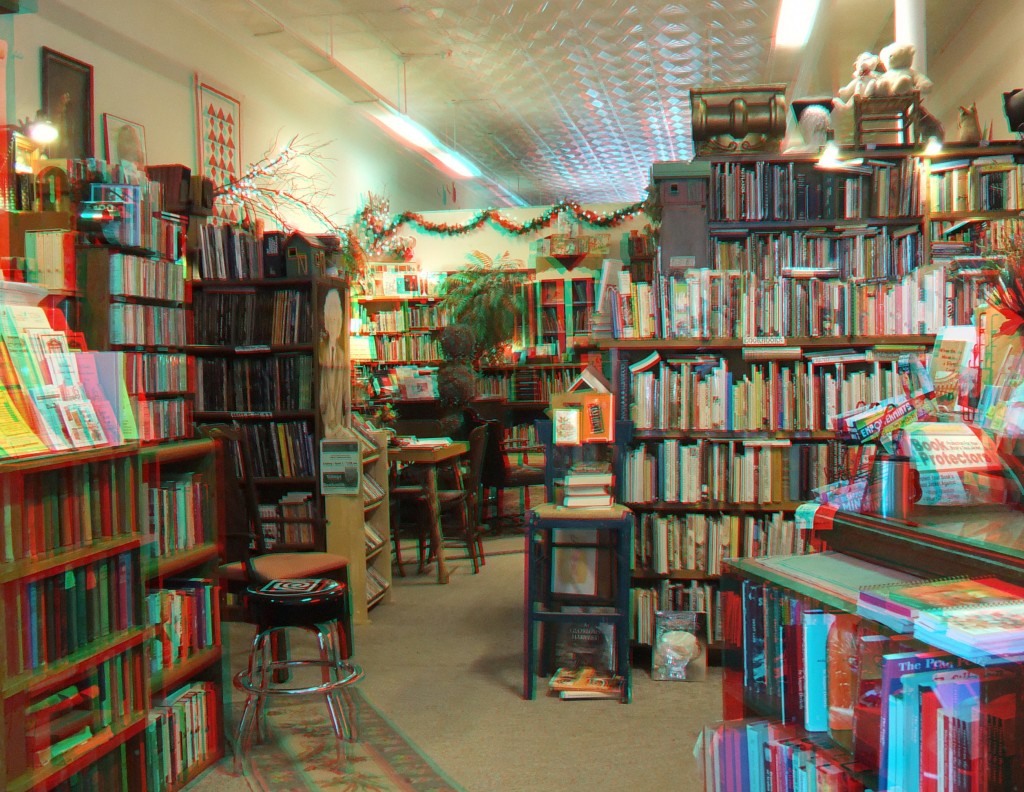
Click on the image to go full size. I think this is one of my favorite images so far!
Rebecca Kilbreath
E-Portfolio Reflection Paper
3 March 2012
At the dawn of my graduate school career I was considering a career change. After a decade in publishing I thought I might prefer a dramatic shift toward library science with, perhaps, an emphasis in archives.
That was my intention in my first semester. The early artifacts in my portfolio reflect that sincere interest in archives and preservation, particularly the paper I wrote, On the Society of American Archivists and the Future of Archiving; the pathfinder I compiled, View-Master Viewers and Reels (a hobby that I was interested in “practicing†my new archiving skills on); and my research on the archives at the Frank Lloyd Wright Home & Studio that resulted in a poster presentation and display.
My portfolio reflects the changing nature of my interests in information science.
While I still find archives an important and interesting field of study, my emphasis changed as my personal and professional life evolved. I was laid off from my publishing job in the middle of my graduate school journey and found myself at a crossroads—I could jump into library science or continue to look for publishing work. As luck would have it, I found a strange place in between.
I took LIS 770 and enjoyed it much more than I was expecting. It was the best of the core classes, in my opinion. I discovered a world beyond archiving and public libraries. I enjoyed thinking about the big picture in terms of organizations and information. I switched tracks and decided to pursue a knowledge management certificate. This was prompted in part by my success and interest in LIS 770 but also by the fact that I was picking up clients and starting my own freelance editing business. Clients were interested in technology, content management systems, web development, and big picture thinking. And, it turned out, so was I.
During LIS 770 I wrote Managing Green: Library Management, Environmentalism, and Economic Reality Collide in Public Libraries. It was a turning point in my education. It combined my background—writing about architecture and green building—with my interest in change management and the future of public spaces.
From there, I took what was for me the best class at Dominican: LIS/GSB 624, Organizational Analysis with Molly Burke. I learned a great deal about the way organizations work. Among the projects I completed for the class was a case study on Proctor and Gamble. I would never look at organizations and corporate culture from the same perspective again.
I also took LIS 880, Knowledge Management. We reviewed numerous case studies and relevant literature that culminated in a long “journal†totaling over 40 pages of analysis and reflection on knowledge management. Having nearly all of my thoughts on a given topic in a single file allowed me to consider all I’d learned and the ways in which those lessons might apply to my burgeoning freelance editing and consulting career.
During the time that my interest had turned to the business and theory end of library science, I was also immersed in learning new skills to add to my resume, including HTML, CSS, content management administration, and much more. I created two websites that are not beautiful but are functional and are stepping stones to greater technical skill and knowledge. Given the skills I brought to the table when I began this journey, they are singular accomplishments despite their seemingly rudimentary nature. I made a personal website for my business, www.rebeccakilbreath.com, and then I made a more advanced website on the same topic: http://786s07.learningdoingsharing.com.
I learned basic HTML, built on that with CSS, and learned a little PHP. From there, I learned about Drupal (a content management system) and content modules and website design and evaluation.
These skills contributed directly to advancements in my career as one of my clients has made me their web editor, responsible for utilizing knowledge management skills in maximizing their website content and traffic. I also inferface with Drupal’s main competitor—Joomla—on a daily basis. I use my content management system skills to improve the frequency of updates and therefore the freshness of my client’s website. I was part of a team that launched their new website, did troubleshooting for them, and continues to de-bug the site on an ongoing basis in addition to posting new content regularly. Because of my success in those areas, the company has also made me a project manager, spearheading webinars and other web-based activities.
The evolution of my interest in information science is evident in my portfolio, and reflects the real-world work opportunities I am encountering.
I hope to continue to employ the knowledge I have gained at Dominican with clients in the future. I would love to start a community of practice in a future position. The paper I wrote, Communities of Practice: A Knowledge Management Power Tool, provides an overview of what a community of practice is, sample case studies, and criticisms related to communities of practice. This is an area that is still ripe for development and I look forward to employing this tool in the future. It’s one of the strongest pieces in my portfolio, I believe.
During my time at Dominican, I have come to appreciate many aspects of library science and librarianship that I had not given much thought to previously. I am looking forward to graduating and pursuing a career track that is not exactly typical of library students but I will continue to support public libraries in any way I can, including volunteering my time and energy.
One of the ways I plan to extend information science in my personal realm is in advocacy and education. I educate my clients on how they can better communicate to their audience, either online or in print. I provide concise and clear social media representation, and I find the best way to provide access to information is via clear communication. It’s our job to create a bridge from information to individuals in our communities.
The first paper I wrote for graduate school was a response to the article “Is Google Making Us Stupid?†The concept of new technology providing access to information but not necessarily knowledge has been a theme throughout my graduate school education. The fact of the matter is that people are barraged with information on a daily basis and it’s our job as information science professionals to help weed out the noise, provide clear pathways to information, operate with informational integrity, and do it all with a strong sense of service and purpose.
That is what I will take from my time at Dominican.